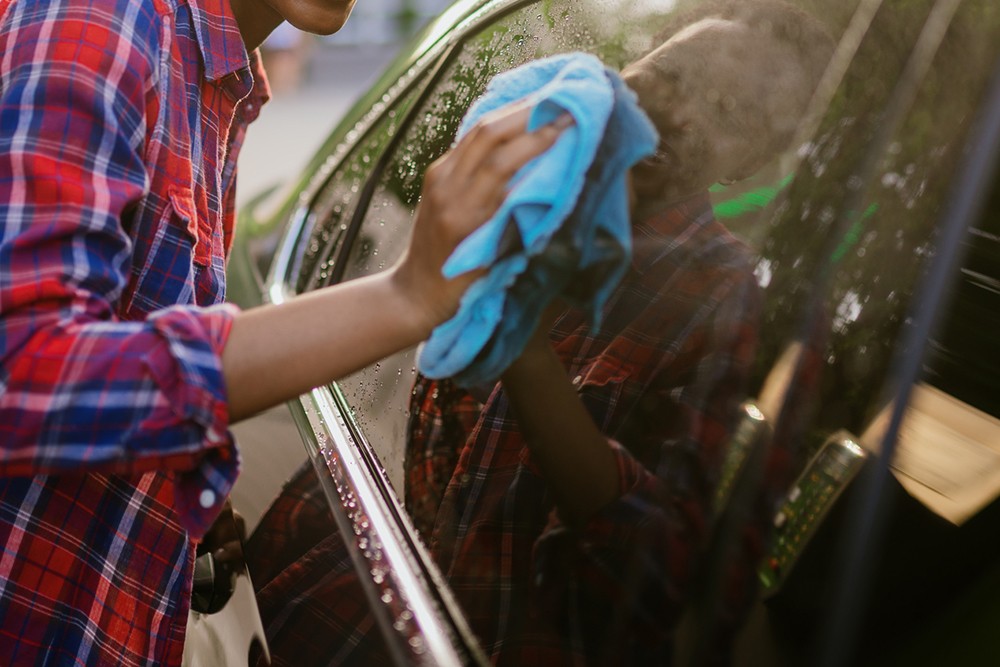Don't Let Dirty, Glaring Windows Dampen Your Outlook

Your car is heading into the season of grime when spring showers combine with the bloom of contaminants such as pollen, dirt and insects–all adhering to your vehicle’s glass surfaces.
To improve your view, day or night, there are a few simple steps to remove that filthy film, water spots and anything else getting in your line of sight.
Window Visibility
When your windows glare back at you, give them the treatment they deserve with these helpful cleaning tips.
1. Clean your vehicle first
Save time by cleaning the interior and exterior of your vehicle before focusing on glass surfaces. Otherwise, you may be adding more work to your busy schedule. Residual suds and water streaks can turn your clear windows into a glaring problem.
2. Wipe off dust and dirt
Always wipe windows with a clean microfiber towel to remove any pollen, dust or dirt. Microscopic dust and other contaminants embedded in used towels can mix with your cleaner. A dirty towel can create crop dust circles and smears across your windows, no matter how hard you clean.
3. Use an appropriate glass cleaner
Using the right glass cleaner is key. There are several options when it comes to glass cleaners for your car. One is to use basic soap, water, a bucket and towels. Or you can opt for a professional glass cleaner intended for automobile surfaces and a microfiber towel.
While there are many cleaning agents you can use, professionals suggest a commercial glass cleaner that is specifically used for auto-glass. Glass cleaners you use inside your home are typically ammonia-based solutions. These mixtures can damage the window tint film by causing blotching and fading, possibly creating cracks and may also eat away at the rubber seals around the window.
4. Use a car window treatment
As we come into the spring rainy season, a traditional water repellent would be a good option to use to avoid harsh water spots on your windows. Re-applying once a month during the rainy season is suggested by car wash professionals.
As an alternative, a ceramic glass-coating repellent will give you months of protection, only having to apply once or maybe twice during the rainy season.
To avoid foggy windows from condensation, use an anti-fog treatment. A liquid-based treatment leaves behind an invisible coating to help prevent fog. Remember, these are to be used on the interior mirrors and windows. Also, be sure to check if it is safe for tinted windows.
Avoid using waxes on your car’s window as they tend to leave surfaces cloudy reducing visibility. This is particularly important to remember on the windshield. Wax polishing compounds used on the windshield may stick to wiper blade rubber surfaces hindering their performance.
5. Avoid streaks
Once you finish cleaning, step back and eye your work. Do you see streaks across your windows or windshield?
Streaks often form when using the wrong cleaner, not using enough cleaner or using a dirty microfiber cloth. It may seem obvious but avoid using a dirty microfiber cloth and don’t use a paper towel to clean or dry your windows.
The key is to use two separate microfiber towels. One for cleaning and one for drying.
Other tips for cleaning vehicle glass
- Spray cleaning solution directly onto the microfiber towel instead of the glass.
- When washing side windows, don’t forget to wipe the top of the window that slides up to meet the rubber seal. This part of the window often gets missed.
- Don’t forget the driver and passenger side mirrors.
- Apply a professional grade glass polish to your windshield in addition to washing it.
- To remove severe water spots, use a glass polish or synthetic steel wool.
- Rain repellents and fog treatments do not harm glass surfaces. They may be applied as often as needed.
- Make it a habit to clean the front and rear wiper blades when cleaning your windows. Simply use a clean cloth or rag to wipe the rubber blades. This doesn’t require extra treatment; just simple cleaning will do.
- Washing your car and its windows is best done in the shade or not on a sunny, hot day. This helps to avoid streaks and is particularly helpful if your car’s windows are tinted.
Tips for cleaning tinted windows
Typically, a car’s window tint is on the inside. So, when cleaning your windows and windshield, you will want to consider a different approach to cleaning your interior windows.
- Use a tint-safe glass cleaner. Avoid using ammonia-based cleaners.
- Avoid using the cleaner near the edges of the tint. There is potential for the spray to get under the tint and cause it to separate from the window. Use a damp cloth to clean the edges.
- Use microfiber cloth to wipe away dirt and dust.
- Avoid using harsh scrubbers like paper towels, newspaper and scouring pads.
- Choose a direction, whether it’s up or down, side to side, or circular. The point is to keep consistent to ensure you’ve covered the entire surface area.
- Dry the windows with a separate microfiber cloth using the same consistent motions.
Other vehicle cleaning reminders for March
- After winter, avoid unnecessary harm to your car and thoroughly clean its undercarriage. Winter weather can cause salt, grime and tar to collect in places you don’t see.
- Clean your vehicle’s mats and interior surfaces to avoid mildew and salt corrosion (if in an area with snow).
- Clean your wheels and tires as brake dust collects on wheels along with other road grime. Pitting or staining of the wheels may occur if not cleaned properly.
- Polish your headlights to improve visibility at night.
- Heading into the warmer months, make sure rubber and vinyl surfaces are protected from the sun. Use a car cover, a protectant spray or a windshield sunshade to help preserve surfaces.